EHDD is a California firm with a long history in deep-green design, and several net zero energy buildings—such as the David and Lucile Packard Foundation in Los Altos, California, and the Exploratorium, on San Francisco’s Embarcadero—in its portfolio. But one-off projects like these, says principal Scott Shell, can’t provide a remedy at the speed and scale we need to tackle the climate emergency. “We need a solution for a majority of buildings, not just for exceptional buildings.”
Shell and many others see potential in a trend known as electrification, a term that describes substituting oil- and gas-burning equipment with electric systems for space- and water-heating, and using all-electric technologies for cooking. By transitioning from burning fossil fuels on-site and instead relying on the grid, we can significantly reduce greenhouse-gas emissions, since electricity is increasingly being generated from carbon-free resources like wind and solar energy.
States and cities—many of which have ambitious climate targets—are propelling this movement forward. The first to act was Berkeley, California. In July 2019 it banned gas connections to new small and midsize residential buildings. Since then, similar policies have been sweeping that state, with 38 additional jurisdictions adopting regulations that either prohibit or discourage gas infrastructure in new construction. Some California cities are already broadening the scope of regulations adopted only a few months earlier. For instance, in San Francisco, the Board of Supervisors adopted two ordinances in January 2020—one that bans gas connections in new or significantly renovated municipal facilities, and a second one that sets a higher energy-performance bar for buildings that opt to include gas infrastructure. Now officials there have approved legislation that will prevent the city from issuing building permits for any new construction with gas hookups, starting in June 2021.
The flurry of activity is not limited to California. Building-electrification policies have been proliferating elsewhere, including Brookline, Massachusetts, where, in November 2019, Town Meeting members overwhelmingly approved a bylaw to prohibit oil and gas infrastructure in new buildings and significant renovation projects. Though the Massachusetts attorney general has struck down the measure for being in conflict with state laws, a coalition of electrification proponents, including AIA Massachusetts, is now recommending legislative action at the state level. Meanwhile, officials in Seattle are in the final stages of adopting a code that eliminates gas space-heating in new commercial buildings and gas water-heating for new hotels and multifamily buildings taller than three stories. An executive order, signed by the mayor, is already in place that prevents new municipal buildings from using fossil fuels for space- and water-heating or cooking. And in Washington, D.C., the district’s Department of Energy & Environment has laid out an electrification timetable that ends gas hookups in new construction or major renovations by 2026. It also requires that replacement heat and hot-water systems be electric by 2035, and calls for residential construction, both new and existing, to be all-electric by 2050.
A confluence of developments is making all-electric buildings a powerful strategy to help alleviate the climate crisis. The most consequential is the transition toward a cleaner grid. In 2019, approximately 38 percent of the country’s electricity was generated from non-fossil-fuel sources, including nuclear, wind, hydropower, and solar, up from about 30 percent two decades ago, according to the U.S. Energy Information Administration. The proportion of electricity generated from, in particular, wind, solar, and biomass is rapidly expanding. According to Headwaters Economics, a nonprofit research group, between 2012 and 2020, 891,383 megawatts (mW) of new generation capacity from these sources was added to the grid, while only 35,302 mW of natural gas capacity was added. At the same time, coal-fired power plants are being retired, notes Mike Henchen, a principal on the carbon-free buildings team at the Rocky Mountain Institute (RMI), a research and consulting organization focused on resource efficiency. “The grid has gotten cleaner faster than many people realize,” he says.
Sources say electrification makes good climate sense even before the grid is entirely fossil-fuel-free. For instance, the Urban Green Council, a New York–based sustainable-building nonprofit, has studied the carbon implications of retrofitting the city’s multifamily buildings with all-electric space-heating and hot-water systems. Currently, oil- and gas-burning equipment in residential buildings accounts for 40 percent of New York’s overall carbon emissions, says John Mandyck, the council’s CEO. The analysis modeled the new systems and those they would replace at various levels of efficiency, and took into account the evolving nature of the electrical grid. For nearly all scenarios, it determined there would be carbon benefits to making the switch in the near term, even though two-thirds of the city’s electricity is currently generated by burning oil and natural gas, and despite the fact that its power supply will become even more carbon-intensive with the shutdown of an aging nuclear power plant in nearby Westchester County slated for 2021. Urban Green predicts emissions reductions will be even greater from such retrofits once renewable generation capacity is added to the electrical grid in 2030 and beyond.
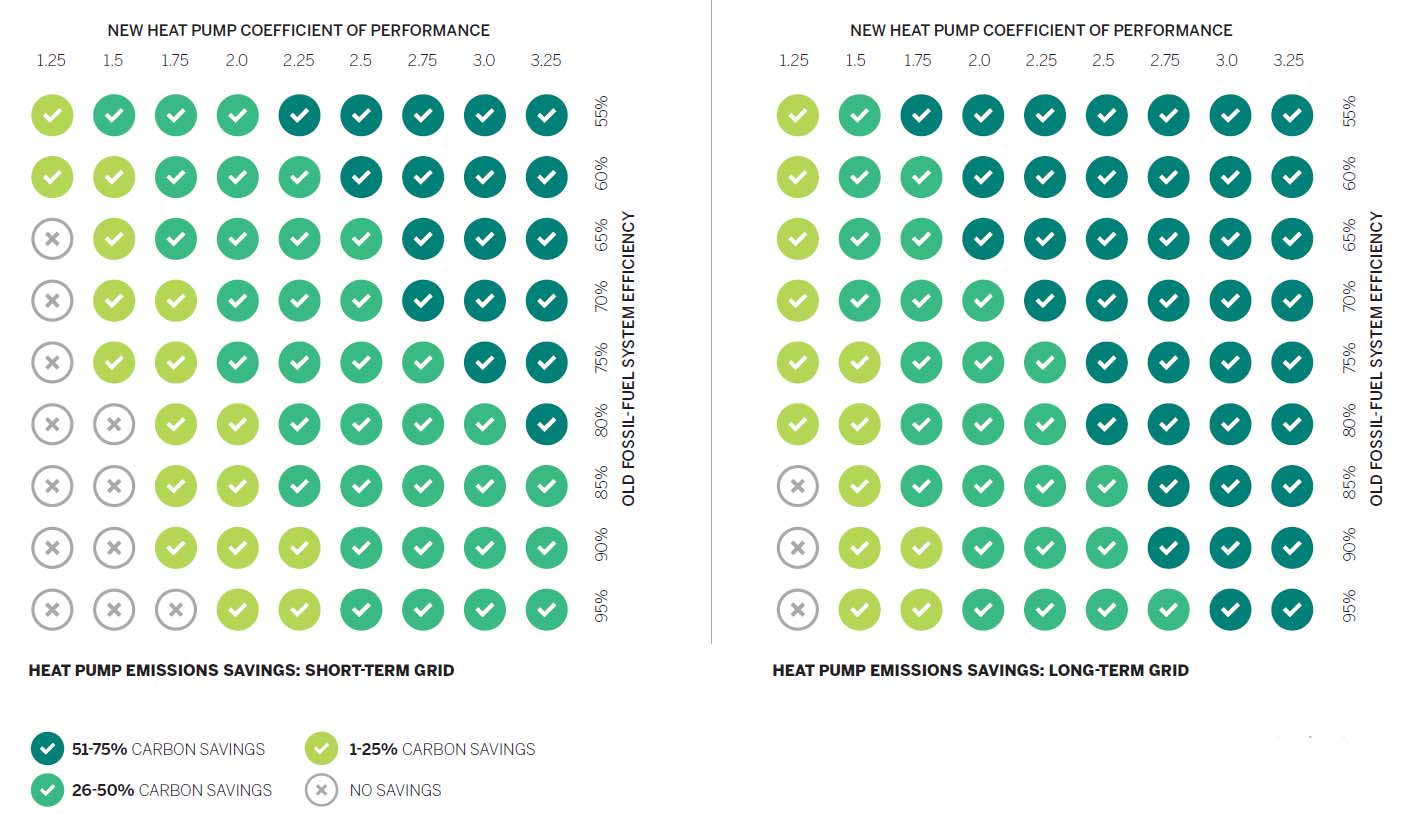
Click diagram to enlarge
Retrofitting New York’s multifamily buildings to electric space- and water-heating would achieve carbon savings now (left), according to the Urban Green Council. The savings would be enhanced as more renewable capacity is added to the grid (right). Image courtesy Urban Green Council
In addition to a cleaner grid, technological advances are propelling the electrification movement forward. Improved equipment for space heating and hot water are making the transition practical: the game-changer is the greater efficiency of heat pumps, devices similar to air conditioners, but that provide heating as well as cooling. With the help of refrigerants, compressors, and the second law of thermodynamics, air-source heat pumps (the most common type) pull heat from outside and transfer it indoors in the winter, and, in the warmer months, they extract heat from the indoor air and release it outside. Although the technology isn’t new, the latest generation of these machines, unlike earlier ones, work when temperatures dip well below freezing, making them a legitimate space-heating option for colder regions of the country. They are more efficient than their fossil-fuel burning counterparts, since they transfer more thermal energy than they consume.
Innovations in electric kitchen appliances, namely the induction stove top, are also making the transition practical. While consumers have been slow to embrace the technology due to “cultural barriers,” says Panama Bartholomy, director of the electrification-advocacy group Building Decarbonization Coalition, he and others tout the benefits of all-electric cooking, including improved indoor air quality (gas ranges and ovens emit toxic gases such as nitrogen dioxide and carbon monoxide); efficiency; and a cooler kitchen.
Some housing developers are betting the public will come around. A 40-story building slated to break ground in downtown Brooklyn next year will be New York’s first all-electric residential tower, according to Alloy, its architect and developer. AJ Pires, the company’s president, cites a number of factors in switching from burning fossil-fuel energy on-site, including the difficulty of coordinating underground infrastructure in a dense urban environment, near a major subway and commuter-rail hub, and the requirements of New York’s Local Law 97, the 2019 legislation that set tough limits on the amount of carbon that buildings can emit. Pires believes that electric boilers for hot water, heat pumps for space-heating, an energy-recovery system, and the induction cooktops will appeal to prospective tenants: “We think the appliances will provide a market advantage,” he says.
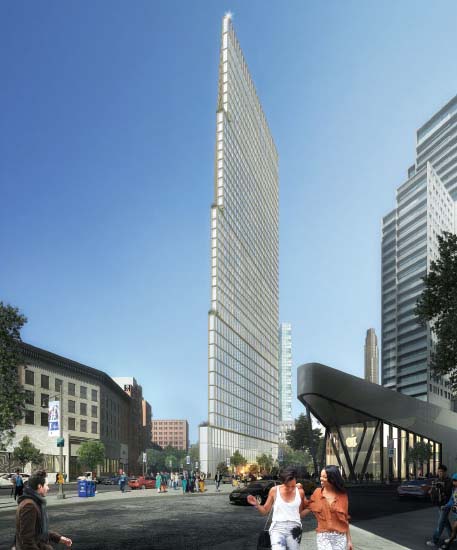
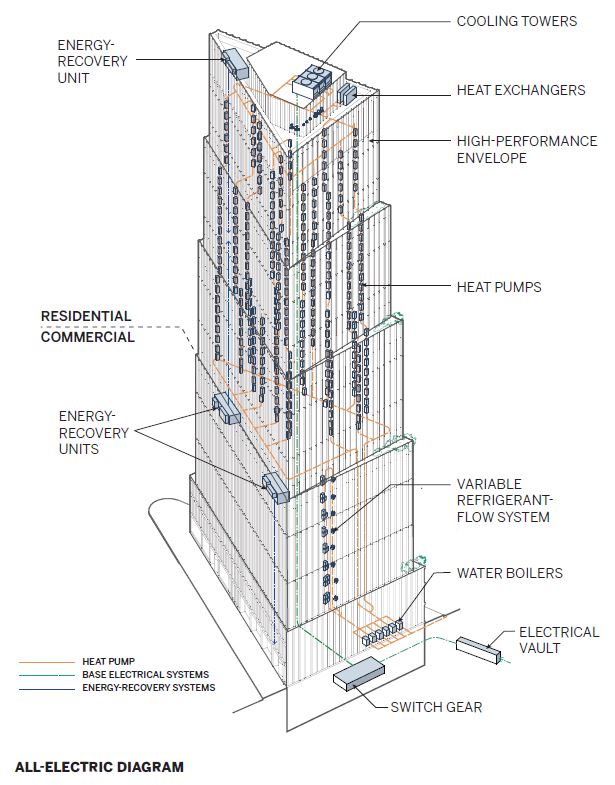
A 40-story tower planned for downtown Brooklyn will have all-electric systems, including those for cooking. Its designer and developer, Alloy, is betting that this strategy will provide a market advantage. Images courtesy Alloy
Beyond climate benefits and the health and comfort of occupants, analyses show that going electric often can save money. A recent RMI study compared the cost of building and operating a new all-electric single-family house to that of one relying on gas for cooking, space-heating, and water-heating in seven U.S. cities: Austin, Texas; Boston; Seattle; Columbus, Ohio: Denver; Minneapolis; and New York. Some findings were surprising, says RMI’s Henchen. Though up-front costs for the mixed-fuel house were higher in most of the cities analyzed, in Minneapolis—which was the coldest climate considered and required the most expensive heat pump—the cost of building the two options was roughly equivalent. However, operating costs for the non-gas house were 9 percent lower, due to a special winter electric-heating rate offered by the local utility. The analysis of Boston, meanwhile, revealed higher annual utility rates for all-electric, but these were outweighed by savings in up-front costs. All of the cities showed considerable carbon savings for the electric-only scenario, especially Seattle, where greenhouse-gas emissions with all-electric over the next 15 years would be a stunning 93 percent lower.
Electrification fans say that such remarkable emissions reductions don’t mean that architects can ignore efficiency. “I worship at the church of the envelope,” jokes Bartholomy. A highly insulated enclosure is critical for improving heat pump performance and containing costs, he explains. That, along with other sustainable-design fundamentals, such as proper solar orientation, daylighting, and the optimal configuration of mechanical systems, will prevent the overbuilding of renewable-generation capacity.
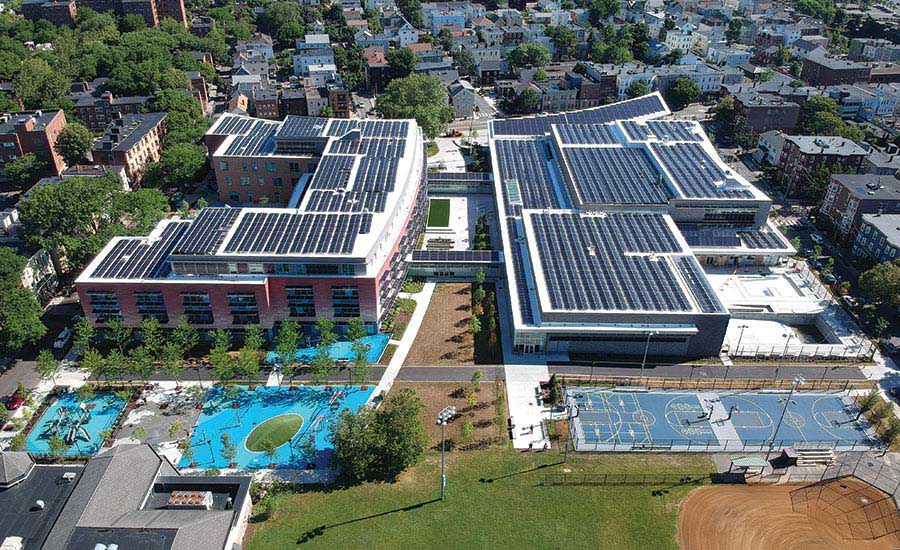
The King Open/Cambridge Street Upper Schools and Community Complex (above and top), has a 3,600-panel, 1.3 mW photovoltaic system on its roofs and window light shelves. Photo © Sophia Panova
Efficiency was definitely top of mind for Boston-based architecture firms William Rawn Associates and Arrowstreet when designing the recently completed King Open/Cambridge Street Upper Schools and Community Complex, in Cambridge, Massachusetts—the first all-electric, net zero emissions school in the state. The 270,000-square-foot development, which includes two public schools, a community library, and district administrative offices, has a 3,600-panel, 1.3 mW photovoltaic system on its roofs and window light shelves, as well as ground-source heat pumps with 197 geothermal wells for radiant heating and cooling. Nevertheless, many other tightly coordinated measures informed by extensive energy modeling were required. To reach the design target of using 43 percent less energy than a typical school in the region, the buildings include thermally robust envelopes, with R-28 brick and terra-cotta wall sections, and R-40 roofs; a lighting scheme that prioritizes daylight over electric illumination; and displacement ventilation tempered by the radiant system. The architects also engaged the users as part of the design process to help them understand occupants’ needs while lowering the complex’s emissions profile. Samuel Lasky, a Rawn Associates principal, cites shared staff workrooms, equipped with fridges and coffee makers, as one product of this process. The idea is that the rooms will deter teachers from bringing their own power-hungry appliances into their classrooms. “Hopefully, these spaces also provide an opportunity to run into a colleague and have a useful conversation,” he adds.
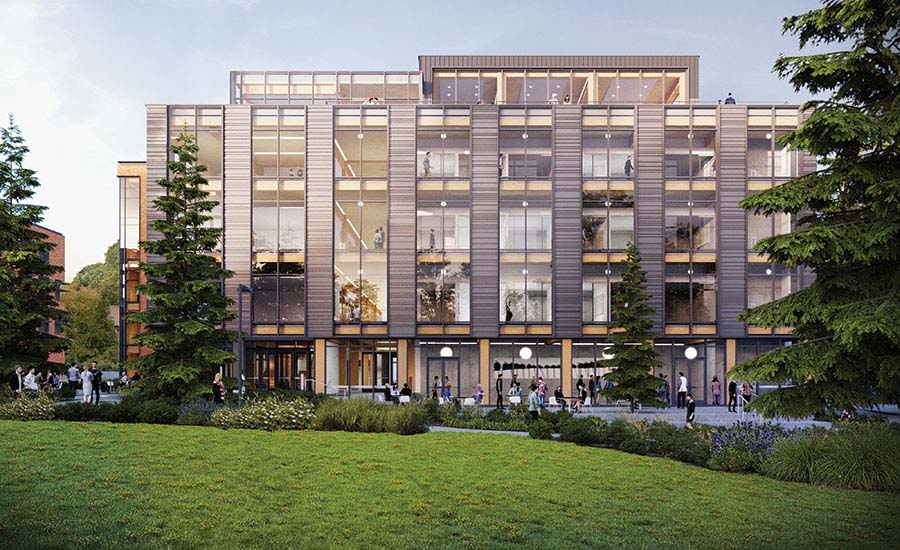
Founders Hall, a building that LMN is designing for the University of Washington’s business school, will forgo a connection to the campus central steam plant. Photo © LMN Architects
Architects are increasingly aware that operations are not a building’s only source of carbon emissions. They are paying closer attention to embodied carbon, the carbon emitted during construction and the manufacturing and transport of materials. Seattle-based LMN Architects, in designing Founders Hall, an 85,000-square-foot academic building for the business school at the University of Washington, now under construction, convinced the client not to hook up to the university’s gas-fired central steam plant and to go all-electric. That approach, and additional strategies such as naturally ventilating the building’s offices, is expected to reduce operational carbon by 85 percent compared with a building that complies with Seattle’s already stringent code. But, on top of that, its mass-timber structure is also a significant source of emissions savings, reducing embodied carbon by 63 percent when compared to using post-tensioned concrete, according to LMN’s calculations.
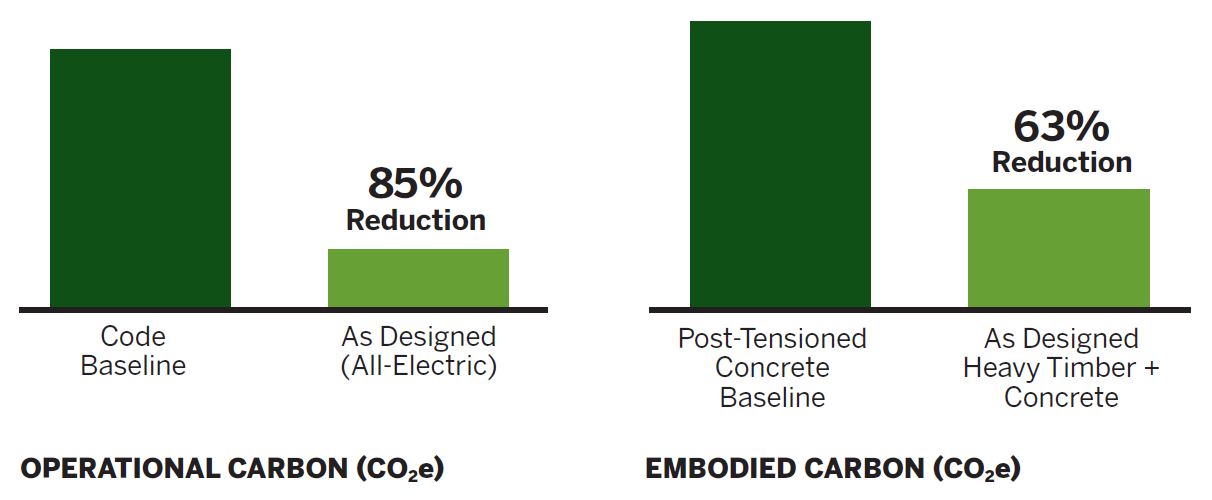
Click diagram to enlarge
By going all-electric and using mass timber, LMN Architects has cut carbon emissions substantially in its design for Founders Hall. Image courtesy LMN Architects
To shrink the emissions profiles of buildings will take all the tricks that design and construction professionals, clients, and regulators have up their sleeves. And to take full advantage of the all-electric trend, they will need to do more than swap out one set of appliances for another. Success will entail additional renewable-generation capacity, improved energy-storage options, and innovations in grid-friendly technologies so that utilities can better manage demand. We will also need equitable funding mechanisms so that low-income communities, who often bear the brunt of the climate crisis, can reap the rewards of an electrify-everything movement.
Significantly, such financing must address the retrofit market, since, as Urban Green’s Mandyck points out, much of our current building stock will be here for a very long time: in New York, 90 percent of the structures that will exist in 2050 are already standing. If we don’t confront that challenge soon, he says, we will run out of ways to reduce emissions. “Our carbon footprint will already be baked in.”
Continuing Education

To earn one AIA learning unit (LU), including one hour of health, safety, and welfare (HSW) credit, read the article above and:
- Going Electric: Retrofitting NYC’s Multifamily Buildings, Urban Green Council, April 2020. (Through page 11) [PDF]
Then complete the quiz. Upon passing the test, you will receive a certificate of completion, and your credit will be automatically reported to the AIA. Additional information regarding credit-reporting and continuing-education requirements can be found at continuingeducation.bnpmedia.com.
Learning Objectives
- Explain how electrification reduces the carbon emissions profile of the built environment.
- Describe current policy and regulations that incentivize or require all-electric construction.
- Explain what a heat pump is and how it works.
- Describe strategies for optimizing energy efficiency in all-electric buildings.
AIA/CES Course #K2012A



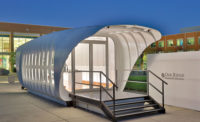

Post a comment to this article
Report Abusive Comment